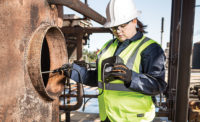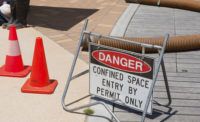This year, as in the past, we’ve read several unfortunate headlines about workers being killed on the job, often in permit-required confined spaces. For instance, seven workers were killed performing maintenance work at a brewery owned by the makers of Corona beer. The cruise ship “MS Pacific,” better known as the “Love Boat” from the television series and sold to scrap this year, claimed the lives of two workers and poisoned eight others while they pumped water from the ship’s engine room. These recent incidents indicate that, given everything we know about the dangers of confined spaces, workers are still entering them to perform work and are placing their lives at risk by not following established safety standards and failing to maintain continuous air quality monitoring. Although the two mentioned tragic incidents occurred outside of the United States, confined spaces can be deadly in any part of the world.
Staying safe
Specific to the U.S., the standard to follow for confined space work is OSHA 29 CFR 1910.46. This standard defines a confined space and permit-required confined space. A confined space possesses the following attributes; a space large enough for an employee to enter and conduct work in the space; has a limited means of entry and exit; and is not designed for continuous occupancy. OSHA identifies a permit-required confined space as having the potential to contain a combustible atmosphere; contains a material for engulfing an Entrant; an internal configuration such that an Entrant could become trapped; and contains any other recognizable safety hazard. In this article, a protocol of safe air quality monitoring procedures will be described for all who enter confined spaces in order to ensure they will safely exit the confined space. Also included is a recommended procedure for employers and employees to follow before entering into confined spaces.
An up-to-date policy
It is important to develop a comprehensive policy, specific to your organization and the work being conducted, to identify the procedures for working in confined spaces. Update the policy frequently and continually with advancements in technology and with physical updates to your facility. Additionally, have a written policy available in multiple languages for all employees to read before beginning the work. To ensure a thorough policy, a trained safety manager should survey and identify all of the confined spaces located on the company’s property. Any renovations, additions, and new structures which create new confined space locations must be accounted for, including all containers, vessels, trenches and pits.
Well-trained workers
All workers must be trained on confined space entry procedures and should understand the specific role each person has while working at the designated space. As a best practice, the “Entry Supervisor” is the person responsible for the entire confined space entry operation. This person may be assigned to multiple confined space locations on site. This is the person with the experience and knowledge to oversee the confined space entry process. The designated “Entrant” into the confined space receives training and is qualified to perform the work needed to complete the job. He/she is able to properly recognize hazards and exit the space when hazards appear. The “Attendant,” located at the entrance to the confined space, constantly monitors the Entrant. The Attendant must communicate with the Entrant, be aware of the conditions in the space, and recognize when to notify rescue teams in case of emergency. Under no circumstance, including emergency situations, should the Attendant enter the confined space as the Rescuer. Instead, this person is responsible for notifying the confined space rescue team. It has been estimated that 60 percent of multiple victim deaths include untrained rescuers. In the event of an emergency, such as a trapped Entrant who becomes incapacitated, all participants should be trained to use a life line and retrieval system.
Test the atmosphere
Employee training must include the use of monitoring instruments to test air quality. Workers must test the atmosphere before they enter the confined space using a calibrated gas monitor that has been bump tested. The bump test verifies that the sensors will properly respond to a known gas and that the alarms are properly functioning. Before anyone enters the confined space, it must be well ventilated with oxygen levels above 19.5% and below 23.5%, assuming no respiratory protection is worn. When the oxygen level is measured below 10% vol, the confined space should be ventilated to get an accurate lower explosive limit (LEL) reading. Combustible gas levels must be below their 10% LEL, and toxic gas levels must be below the OSHA permissible exposure limit (PEL) of the specific toxins found within the confined space. Two of the most commonly found toxic gases in confined spaces are carbon monoxide and hydrogen sulfide. It is necessary that carbon monoxide levels are below 35 ppm and that hydrogen sulfide levels are below 10 ppm. Following the initial sampling, the air in the confined space should be continuously monitored. This is because toxic and combustible gases can appear from debris being knocked off the sidewalls, floors, or piping as they are cleaned.
Secure the space
A complete training program also includes understanding and using proper methods and systems to ensure the area has been de-energized. For example, lockout-tagout of mechanical and electrical systems prevents injury or death from machinery being turned on or electrocution occurring when electrical circuits are reconnected. Also, the use of double block and bleed isolation is used to prevent asphyxiating toxic gases or combustible gases from entering the confined space area.






